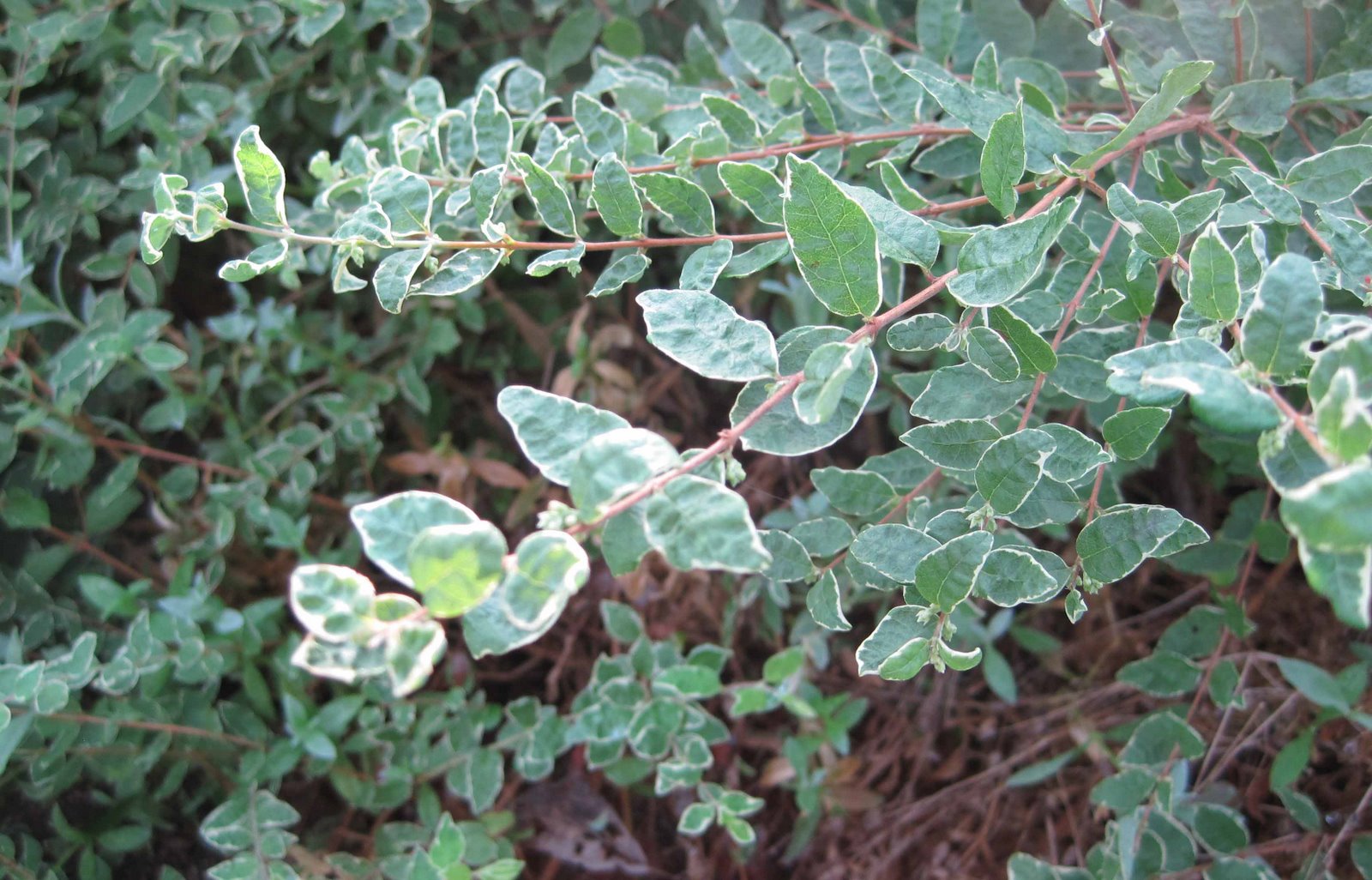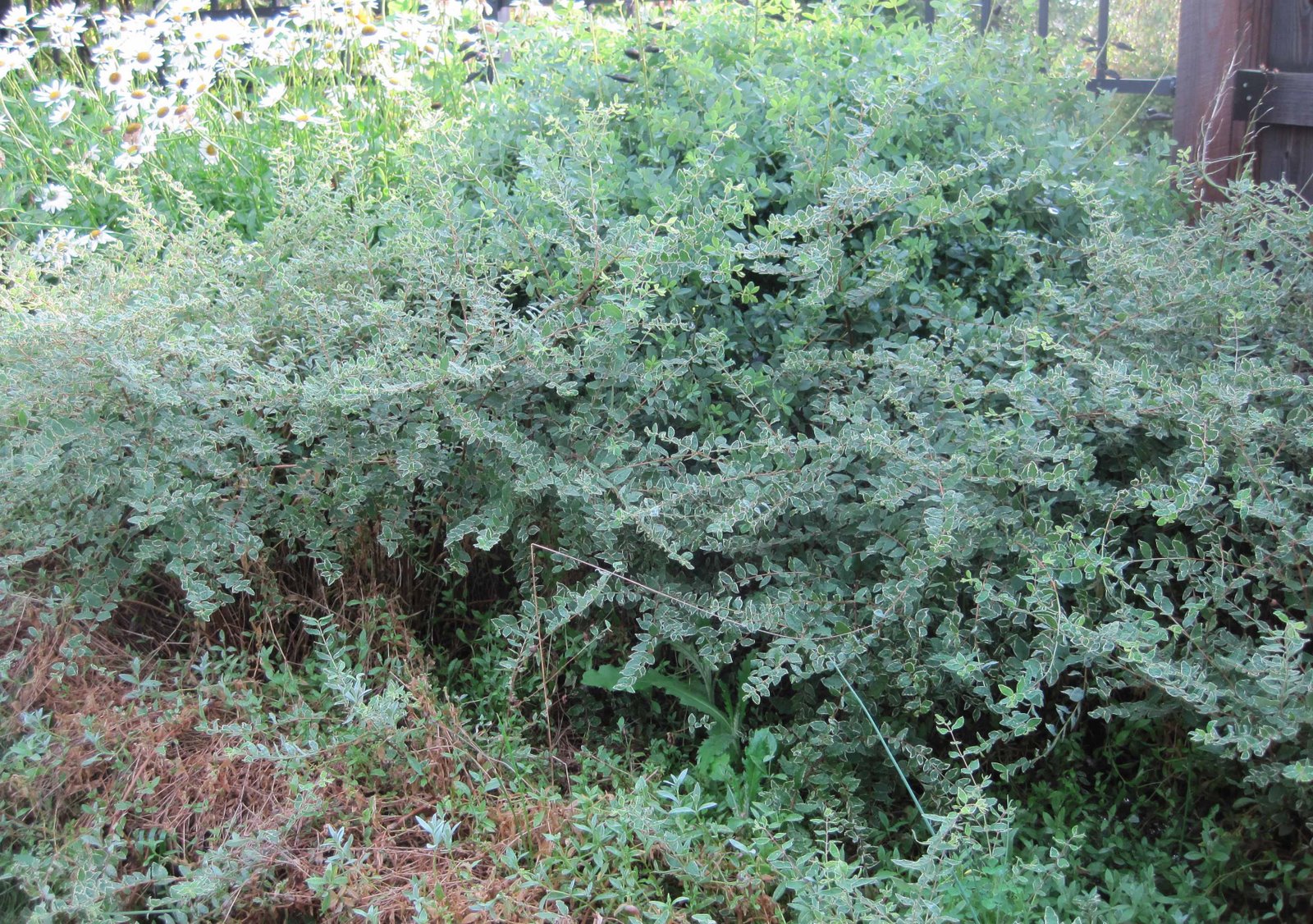 When I first read the tag, I read…
When I first read the tag, I read…
“Carol, I am the plant for you. Look at my pretty little variegated leaves. I promise to be a good plant if you’ll just plant me in your garden. I promise to not take up much room, and since I’m more of a shrub, I’ll provide a little structure to your new perennial border. Please buy me!”
It was love at first sight. I rubbed my eyes and read the tag again, just to make sure I’d read it right the first time….
Variegated Coralberry
The common Coralberry but with distinctively variegated leaves. Very appealing shrub that appears silvery from a distance. 3 to 4 ft. high and wide. Full sun to heavy shade.
How could I go wrong with this gem of a shrub? So I bought the little coralberry and planted it in my perennial garden, way at the very end. You know, that end of the garden which seems to be the last place you get to when you are weeding, because you always start weeding at the other end, so that by the time you get to that end, you are tired and don’t really get to all the weeds. That’s where I planted this little plant with so much promise.
Over the years, I forgot about it. It never flowered. It never had any berries on it. It was just a small shrub with variegated foliage. I let Snow-in-Summer grow up around its base. I planted a Baptisia to one side of it and a small ‘Miss Kim’ Lilac on the other side of it. I let tall weeds grow behind it, because it was on that end of the garden that didn’t get a lot of attention. Eventually, I even forgot its name.
I did notice that it was trying to spread by runners, and when I had the time and inclination, I whacked those back and tried to contain it, this now nameless shrub. I noticed that it was starting to encroach on the Baptisia, with its gorgeous purple flowers in the spring. It started to annoy me, this now nameless variegated leaf shrub that I surely once loved to have bought it in the first place. But we were clearly not on a first name basis. We barely spoke and when we did it was all questions about who are you, why did I buy you, what did I see in you to begin with and accusations about spreading out and taking up too much space. I was ready to pull it out once and for all.
Then the other night I looked through my plant tags to find its tag because I wanted to know its name before I dug it up. But I couldn’t find a tag so I put a picture on Twitter and asked for help with identification. Privet? No, not tall enough, and besides I’d never buy a Ligustrum of any kind. Eleagnus? No. Some conversations moved off to email, then back to Twitter. Finally, Annie in Austin suggested Coralberry after my mention of horizontal spreading above ground stems triggered a memory from one of her gardens.
Coralberry? That sounded right. I looked again at my tags, this time looking through the “dead plants” file and I found it. Yes, Coralberry!
I did some online searches and read more about it. I went out and looked at it. The species is native. It can grow just about anywhere. It’s good cover for small birds. I took some pictures. I saw some tiny blooms, which meant there would be berries, food for the birds. Perhaps I wished it gone too soon?
I knew it before I thought it. I’m not going to get rid of it. I like it now. The tag was right, even if it didn’t mention how it spreads. It is a pretty shrub.
But I promise myself and the Coralberry that from now on I’m going to contain it. I’m going to cut it back away from the Baptisia, and cut back that Snow-in-Summer at its base. And the next time I weed that perennial border, I’m going to start on that end, where the Coralberry is, where Symphoricarpos orbiculatus ‘Taff’s Silver Edge’ with its distinctively variegated leaves that appear silvery from a distance grows. I’m going to take care of it, this very appealing shrub that I would now seek out in the garden center if I didn’t already have it.
Welcome back, Coralberry!


I have never seen the variegated, it should be nicer than the green which is very non-descript until the berries show up. It is a great plant for winter interest because those berries hold their color until spring, at least it does here.
It is a pretty thing! Hope it does flower for you this year.
I have native Coralberry in the front garden and it does indeed wander where it wishes. Like you, I just whack it where I don't want it. Mine doesn't get more than 12 inches tall, though, if that. It berries up nicely and it's a good groundcover.
I think it would be nice if you could let it grow and make a colony. I tore mine out after about 8 years of growth. I didn't find any activity of birds in it. The bugs did like them though.
A silvery shrub that produces berries in shade sounds like a winner. I want one.
Donna
I try to mix up my weeding routine just for that reason: so some areas don't get neglected.
We have some of that in the woods behind our yard. It grows fast and stretches out. I thought it looked neat so I transplanted a couple closer to the house. That was a mistake! The runners threatened to take over so they were removed. Of course your variegated one looks much nicer than what I had.
Aw, I love a story with a happy ending. Shrub meets gardener, shrub gets gardener, shrub loses gardener, shrub gets gardener back. I hope you both live happily ever after. It is very pretty. I'm not familiar with it even though it is a native. Must investigate.
I didn't recognize it with the silver edge, but Coralberry grows wild here in the woods and woods' edge. I often pull up its runners unintentionally when I'm pulling up honeysuckle. Mine doesn't flower in the woods, but at the woods' edge the berries look nice in the winter against the bare stems. The cut-flower sellers in the farmers' markets sometimes have stems to sell in the fall.
What a little love story. Full circle; through no fault of it's own it was loved-hated-and loved again. A happy ending indeed. Long may the Coralberry rein in 'that part' of your garden, with a little tlc you two could be best friends.
Sometimes those "Indie" Romances are downers, Carol – glad your story will have a happy ending!
With the cultivar name refound, you can now have more garden geek fun by putting "Taff's Silver Edge" (include quotation marks) into google to find Stephen Taffler, the amateur British botanist who selected it. Since you have such a close relationship with your coralberry, you can just call it Steve!
Annie at the Transplantable Rose
The thing I like about 'Comments' is that you not only get more information about a plant's requirements, you also get information about a plant's history and a tip about a Google search. Thanks, Carol and Annie and everyone.
Thanks for sharing the story of oralberry. It was nice going through it.
Hello from Carol in Nora! Any idea if Coralberry can still be had here in Indy? Also, is it worth a trip down to Soule's for some perennials? The plant selection at this end of town is sort of sparse already!
Thanks everyone for the great comments. To Carol in Nora, I don't know if you can find this Coralberry anywhere now. I bought it 10 years or so ago at Avon Gardens on the westside. For perennials… Soules Garden is a great place to visit for daylilies and hostas, but they don't have a big selection of other perennials. Avon Gardens in the past has had a lot of perennials but I haven't been there recently. Both Soules Garden and Avon Gardens are nice to visit, though, just to see the gardens themselves.
Carol, May Dreams Gardens